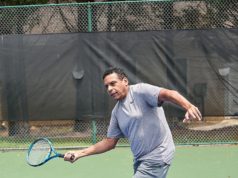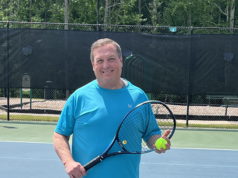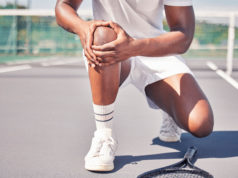By Marcus Hurtig, USPTR, TCAV, Martin’s Landing Director of Tennis/Pickleball
If you have played tennis for much of your life, like most of my students and I have, you probably have suffered an injury. My students’ injuries have ranged from the limiting (tennis elbow, plantar fasciitis) to the debilitating (herniated disc). Treatments included surgery (even joint replacement), hospitalization, physical therapy, and taking a break from playing tennis — all of which were eventually effective in most cases and allowed the student to resume playing.
Avoiding future injury and re-injury is something I focus on regularly with my students. The range of tennis-related injuries we try to avoid includes, but is not limited to the following:
- Tennis elbow and golfer’s elbow
- Back injury (pulled muscle, back strain, bulging or herniated disc)
- Plantar fasciitis (heel pain caused by tendonitis)
- Calf muscle or Achilles tendon strain
- Hand, thumb, and finger injury
- Carpal tunnel and tendonitis of the wrist
- Hip pointer
- Hamstring pull
When I am helping a student come back from an injury, I try to educate them on how to use strategies that will help them to avoid re-injury, including the following:
- Swing mechanics — Particularly for tennis elbow, I have found that focusing on full arm extension and body position relative to the ball, as well as completing the follow-through can help limit the stress placed on the elbow.
- Stretching and warm-up routines — I advise my students to arrive early to a match or lesson so they can stretch and also engage the muscles they will be using.
- Stretching and cool-down routines — Stretching after a match also can help avoid re-injury. Ice or heat may be helpful as well.
- Equipment — The right shoes are essential to avoiding injury. If you play tennis every week, your shoes will wear out faster. I recommend new shoes every three to six months for active players. Even if the tread is not completely worn down, the arch support may no longer be adequate. Racquets should be restrung regularly, as soon as wear is evident across the center of the racquet. Dampeners are essential for reducing vibration that travels up the racquet to the hand, wrist, and elbow. I recommend both worm and round dampeners be used together.
- Supports — A variety of braces, wraps, and athletic tapes are available for arms, knees, ankles, shoulders, and virtually all problem areas. A doctor or physical therapist can instruct you on the best supports for your injury.
- Strengthening — I work with many players during our coaching sessions on strengthening the muscles that support their joints, which is critical to avoiding injury, and will help their tennis game and endurance. A personal trainer or physical therapist also can advise you on how best to strengthen your muscles to support, rather than aggravate, a prior injury.
I want all my students to continue to improve their game, and to play the best tennis of their lives. Sometimes that means learning to play within the limitations of our bodies, particularly as we grow older. Tennis is a great sport that we can play for our entire lives, and managing injuries is an important aspect for both players and coaches. Finding the right tennis coach can help you extend your tennis career, play with less pain and injury, and keep you in the game.




